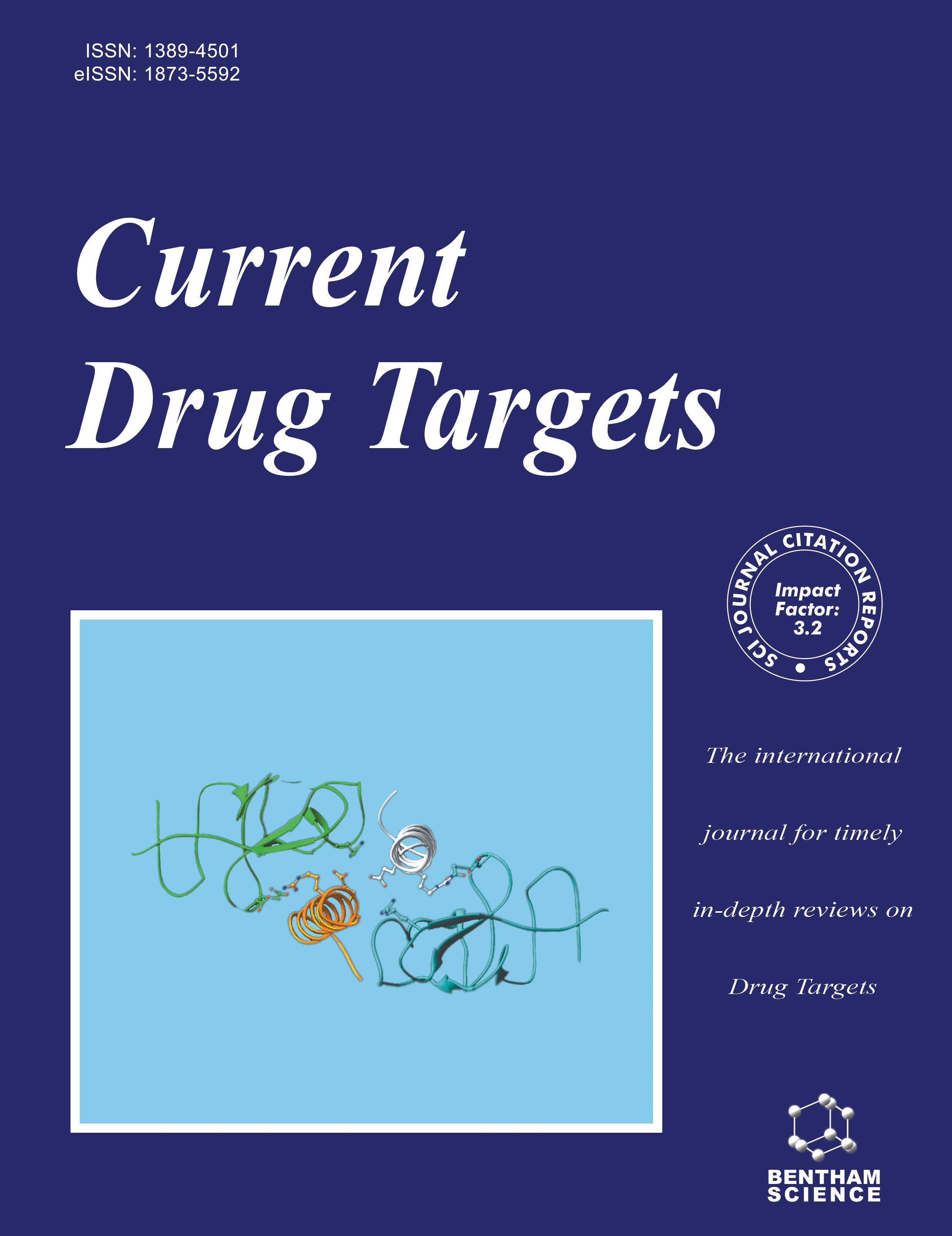- Home
- A-Z Publications
- Current Drug Targets
- Previous Issues
- Volume 18, Issue 8, 2017
Current Drug Targets - Volume 18, Issue 8, 2017
Volume 18, Issue 8, 2017
-
-
Molecular Bases of Chemoresistance in Cholangiocarcinoma
More LessAuthors: Jose J.G. Marin, Elisa Lozano, Oscar Briz, Ruba Al-Abdulla, Maria A. Serrano and Rocio I.R. MaciasThe multidrug resistance (MDR) phenotype accounts for the poor response of cholangiocarcinoma to available antitumor drugs. This is an important limitation to the use of pharmacological approaches, both as adjuvant therapies and for treating advanced CCA when surgical removal is not possible. MDR is the result of a complex combination of defense mechanisms against toxic compounds already present in cholangio Read More
-
-
-
Current Targets for Primary Sclerosing Cholangitis
More LessAuthors: Irene Pierantonelli, Antonio Benedetti and Marco MarzioniPrimary sclerosing cholangitis (PSC) is a biliary disease characterized by liver inflammation and death of cholangiocytes which, in turn, drive to fibrosis, cirrhosis and functional alterations of the liver. PSC is also associated with an increased risk of developing cholangiocarcinoma. To date, the etiopathogenesis of PSC is still not completely understood, although a genetic predisposition in association to environmental factors cont Read More
-
-
-
New Advances in the Molecular Mechanisms Driving Biliary Fibrosis and Emerging Molecular Targets
More LessPersistent exposure of biliary epithelial cells (i.e., cholangiocytes) to diverse factors such as disordered immunity, genetic alterations, ischemia, toxic compounds and/or infectious agents leads to a chronic portal inflammatory response which eventually progresses to biliary fibrosis. This stage is characterized by increased production and deposition of scar-forming extracellular matrix proteins (ECM), in particular fibrillar collage Read More
-
-
-
Cell Death and microRNAs in Cholestatic Liver Diseases: Update on Potential Therapeutic Applications
More LessAuthors: Rui Eduardo Castro and Cecília Maria Pereira RodriguesCholestasis is the main pathogenic event in a wide range of genetic or acquired disorders of bile acid synthesis or bile flow, resulting in intrahepatic and systemic accumulation of bile acids. In turn, augmented levels of bile acids lead to hepatocellular injury and progressive liver damage, eventually culminating in fibrosis and end-stage liver disease. In the injured cholestatic liver, apoptosis has long been recognized as a dir Read More
-
-
-
Molecular Mechanisms of Cholangiocarcinogenesis: New Potential Targets for Therapy
More LessCholangiocarcinoma (CCA) is a heterogeneous group of dysplastic disorders affecting the biliary epithelium. It is the second most common primary liver tumor which accounts for around 3% of all gastrointestinal cancers. CCA is very deadly due to its aggressiveness, late diagnosis and high chemoresistance. The incidence is increasing worldwide and the therapeutic options are very limited. Radiotherapy, chemotherapy, sur Read More
-
-
-
Therapeutic Targets in Polycystic Liver Disease
More LessAuthors: Tatyana V. Masyuk, Anatoliy I. Masyuk and Nicholas F. LaRussoPolycystic liver diseases (PLD) are a group of genetic disorders initiated by mutations in several PLD-related genes and characterized by the presence of multiple cholangiocyte-derived hepatic cysts that progressively replace liver tissue. PLD co-exists with Autosomal Dominant Polycystic Kidney Disease (ADPKD) and Autosomal Recessive PKD as well as occurs alone (i.e., Autosomal Dominant Polycystic Liver Disease [ADPL Read More
-
-
-
Primary Cilia in Tumor Biology: The Primary Cilium as a Therapeutic Target in Cholangiocarcinoma
More LessAuthors: Sergio A. Gradilone, Maria J. Lorenzo Pisarello and Nicholas F. LaRussoCilia are microtubule-based organelles, which are ubiquitously expressed in epithelial cells. Cholangiocytes, the epithelial cells lining the biliary tree, have primary cilia extending from their apical plasma membrane into the ductal lumen, where the cilia function as multisensory organelles transducing environmental cues into the cell interior. The decrease or loss of primary cilia has been described in several malignancies, i Read More
-
-
-
When Neighbors Talk: Colon Cancer Cell Invasion and Tumor Microenvironment Myofibroblasts
More LessAuthors: Jolien Bridelance, Zuzanna Drebert, Olivier De Wever, Marc Bracke and Ilse M. BeckHistorically, the word cancer is derived from the Latin cancer, as the red swollen arteries near a tumor reminded the physician Galenus and his fellow Romans of a red crab. Currently, cancer remains the disease to beat as it remains a leading cause of death worldwide (WHO). Tumors do not simply consist of cancer cells, as they can recruit normal cells, which will form the tumor-associated stroma. These stromal cells togethe Read More
-
-
-
Current Drug Targets in Obesity Pharmacotherapy – A Review
More LessAuthors: Sangeeta P. Bhat and Arun SharmaObesity, an impending global pandemic, is not being effectively controlled by current measures such as lifestyle modifications, bariatric surgery or available medications. Its toll on health and economy compels us to look for more effective measures. Fortunately, the advances in biology and molecular technology have been in our favour for delineating new pathways in the pathophysiology of obesity and have led to subseque Read More
-
Volumes & issues
-
Volume 26 (2025)
-
Volume 25 (2024)
-
Volume 24 (2023)
-
Volume 23 (2022)
-
Volume 22 (2021)
-
Volume 21 (2020)
-
Volume 20 (2019)
-
Volume 19 (2018)
-
Volume 18 (2017)
-
Volume 17 (2016)
-
Volume 16 (2015)
-
Volume 15 (2014)
-
Volume 14 (2013)
-
Volume 13 (2012)
-
Volume 12 (2011)
-
Volume 11 (2010)
-
Volume 10 (2009)
-
Volume 9 (2008)
-
Volume 8 (2007)
-
Volume 7 (2006)
-
Volume 6 (2005)
-
Volume 5 (2004)
-
Volume 4 (2003)
-
Volume 3 (2002)
-
Volume 2 (2001)
-
Volume 1 (2000)
Most Read This Month
Article
content/journals/cdt
Journal
10
5
false
en


